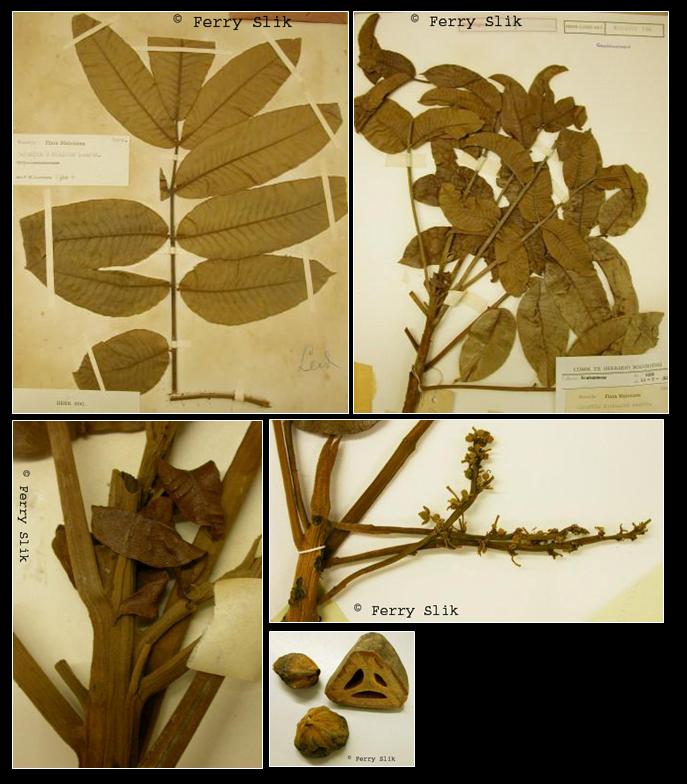Canarium decumanum [Rumph.] Gaertn., Fruct. 2 (1791)
Latin for 'the tenth, or biggest'.Synonyms
Canariopsis decumana Bl. ex Miq.
Pimela decumana Bl.
Description
Tree, 30-60 by 1.5-2 m, with very large buttresses (up to 8 m high and 5 m wide). Branchlets
1-1.5 cm diam., angular, glabrescent, with large leaf-scars, terminal bud slender, acute, 4-5 cm by
6 mm, densely brown-tomentose; pith thick with many peripherally arranged small vascular strands.
Stipules represented by the basal pair of leaflets, which are rather caducous leaving a small circular
scar, inserted at the conjunction of branch and petiole and very small (petiolule 4-10 mm,
blade 1.5-2.5 by 0.75-2 cm). Leaves spirally arranged, (3-)4-5(-6)-jugate, 35-45 cm long.
Leaflets ovate to oblong, 5-10-30 by 2.5-5-10 cm, stiff-chartaceous to coriaceous, glabrescent; base
rounded to subcordate; margin entire; apex gradually long and acutely acuminate; nerves
17-22-26 pairs (angle c. 60 degrees), tortuous, towards the margin dissolving into a lax marginal
reticulation, rather prominent beneath, some of the nerves more or less reduced (similar to intermediate
veins); reticulations dense. Inflorescences axillary, narrowly paniculate, densely minutely tomentose,
male 4-19 cm long, many-flowered, main branches up to 6.5 cm, flowers clustered; female 5-7 cm, few
flowered, main branches very short. Bracts lanceolate to subulate. Flowers pubescent, male 7-9 mm,
female 8-14 mm. Calyx male 3.5 mm high, female 4.5-7 mm. Stamens free, glabrous. Disk male cushion-shaped,
2 mm high, faintly 6-lobed, densely pilose; female 6-lobed, 1 mm high, fimbriate. Pistil pubescent,
male none. Infructescences subracemose, with few fruits; calyx flat, 1 cm diam. Fruits ellipsoid,
subtrigonous in cross-section, 7-8.5 by 4.5-6 cm, glabrescent, scabrous; pyrene smooth except of
3 angle-ribs near the apex and a faint median rib on each of the lids; lids 4-5 mm thick. Seeds
(3-)2-1 ; cells irregularly shaped, sterile ones not or slightly reduced. [from Flora Malesiana]
Ecology
In undisturbed forests up to 100 m altitude.
Uses
Cultivated, especially in Java, for the fruits. The resin and the seeds are used, but they are of
no great importance.
Distribution
Java, Borneo, Celebes, Moluccas and New Guinea.
Local names
Ambon: kanari ketjil.
Borneo: Jelamu, Jilapat, Kedungdong, Kenari, Pamotodon.
Ceram: glama.
Java: Kenari babi, kenari sabrang.
Moluccas: damar amin, hafu bopolulo, hafu gogira, hafu sula, jal amin, jalo halat, jar amin,
kamal amin, kami, kenari besar, kenari sula.
Morotai: hapo, hoburu.
Ternate: (njiha) hafo.
